| کد مقاله | کد نشریه | سال انتشار | مقاله انگلیسی | نسخه تمام متن |
|---|---|---|---|---|
| 4748227 | 1642101 | 2014 | 8 صفحه PDF | دانلود رایگان |
عنوان انگلیسی مقاله ISI
Crepidolithus cantabriensis nov. sp., a new calcareous nannofossil (Prymnesiophyceae) from the Lower Jurassic of northern Spain
دانلود مقاله + سفارش ترجمه
دانلود مقاله ISI انگلیسی
رایگان برای ایرانیان
کلمات کلیدی
موضوعات مرتبط
مهندسی و علوم پایه
علوم زمین و سیارات
فسیل شناسی
پیش نمایش صفحه اول مقاله

چکیده انگلیسی
A new calcareous nannofossil, Crepidolithus cantabriensis nov. sp., is described from the Lower Jurassic marls and marly limestones of the Cantabrian Range (Northern Spain). The new species is characterized by medium-sized, normal to narrowly elliptical coccoliths with open central-areas. In the light microscope, under crossed nicols and in distal view, it displays a characteristic bicyclic extinction pattern. Its inner rim edge shows maximum birefringence colours, which vary from white to yellow, whereas the faintly outer rim margin exhibits low birefringence, tending to grey, and they are separated by a dark and sigmoidal isogyre. C. cantabriensis nov. sp. seems closely related to Crepidolithus crassus on the basis of shared morphological characters. Both of them have a distal shield composed of around thirty sub-vertical, dextrally imbricating laths. The central-area width of C. cantabriensis nov. sp. is approximately half of the coccolith width, whilst it is reduced to one or two tiny lenticular slits in C. crassus. Nevertheless, the phyletic relationships between C. cantabriensis nov. sp. and Crepidolithus cavus are not clear, since they show different rim structures, and C. cavus has a delicate bar aligned along the minor axis of its central area. The first specimens of C. cantabriensis nov. sp. have been recognized within the Raricostatum AZ in the Tudanca section. This species seems to be more abundant in the Reinosa area, which occupied a more distal position with respect to the Iberian Massif during the studied time interval. It is hypothesized here that C. cantabriensis nov. sp. could have inhabited the lower-photic zone.
ناشر
Database: Elsevier - ScienceDirect (ساینس دایرکت)
Journal: Geobios - Volume 47, Issues 1â2, JanuaryâApril 2014, Pages 31-38
Journal: Geobios - Volume 47, Issues 1â2, JanuaryâApril 2014, Pages 31-38
نویسندگان
Ángela Fraguas,